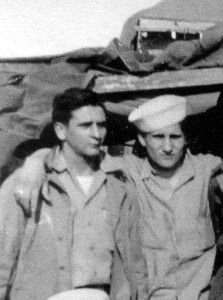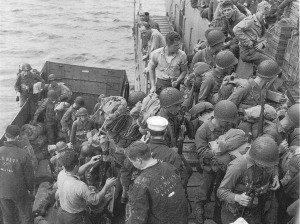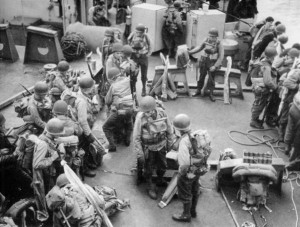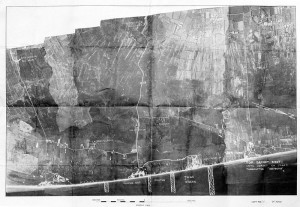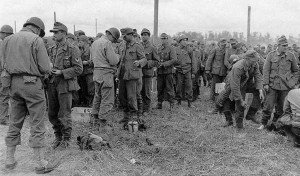“It was as though the curtain was about to go up on one of the biggest shows in history, and I was part of the cast! I knew it was going to be a small part, but the overriding sense of it all was that I was there!”
Raymond L. Acosta, part of the Naval Officer in Charge (NOIC) group of the U.S. Navy during the Normandy Campaign, gives his firsthand account of the wide range of emotions he felt as a young man getting the news that he and his fellow troops would be heading to Utah Beach on D-Day:
I was five days into my 19th birthday as we approached the Normandy coast on June 5, 1944 – and completely unaware of what was to happen on the beaches…Just before dawn, in the cool air of the pitch black night, I was suddenly numbed by the enormity of what was about to happen. It was as though the curtain was about to go up on one of the biggest shows in history, and I was part of the cast! I knew it was going to be a small part, but the overriding sense of it all was that I was there!
It all started seven months earlier, when I arrived near Roseneath, Scotland, aboard QE1, as a Navy radioman, assigned to the Commander of the Eleventh Amphibious Force (later annexed to the Naval-Officer-in-Charge, Utah Beach – (NOIC- Utah Beach). On May 16, 1944, after six months of duty in Wales and England, we were all assigned aboard Liberty Ship S/S Robertson. For three weeks we remained on board as a ‘sealed ship’, sailing back and forth between Penarth (Wales) and Plymouth (England). A most boring tour of duty, if you ask me. But then we heard, that we were to be part of a vast mobilization of allied forces getting ready to invade the European continent…we knew it was going to happen soon, but the big question remained: where.
Meanwhile, almost every week, six or seven operators (of our original group of 35) got assigned to other ships, until there were only 12 of us left on the S/S Robertson. We all felt sad, since we had been together since our radio training at Northwestern University. On June 5, 1944, we set sail for Barry (Wales). During the afternoon, our skipper, Commander Dunn, called for attention and read a message from Rear-Admiral Alan G. Kirk, commanding US Naval Assault Forces. It was a grim message, about what was to be expected from the enemy, in the coming battle. I could feel the adrenalin surging through my whole body (recalling the tragic incidents during ‘Operation Tiger’), but still managed to say to one of my shipmates, with a dry throat, “I guess, this is it !” From that moment on, until two weeks later, I went into a kind of trance, though I was aware of everything that was happening around me, I guess I was unconsciously creating a mental fog to act as a kind of protecting shield. Yet, I was able to write about these historic events in the little diary I carried with me.
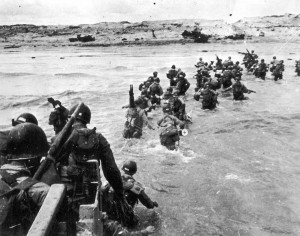
American soldiers landing on Utah Beach. (June 6, 1944). Source: Regional Council of Lower Normandy, U.S. National Archives.
This was D-Day, June 6, 1944 – the big day has come! And here we are cruising along to France to set up a Comcenter on the Utah Beachhead (NOIC-Utah Beach). We’re all pretty nervous and jittery, wonder what it will be like when we get there? We’ll sure know within a few hours. So far, only one enemy E-boat contact…everything was black and quiet as we sat top side on the hatch covers preparing our individual gear, when suddenly a battleship opened up nearby with its 12-inch guns, the noise was incredible. Sound waves literally entered our mouth and nose, and hit right into the pit of your stomach. Next, the sky lit up with millions of tracer fire, both sound and sight were truly awesome. It looked, no it was, the world’s greatest fireworks! I remember, feeling uncomfortable, because I thought it was so damn beautiful, how can anything so destructive, be so beautiful? As I was going down the cargo nets on the S/S Robertson’s portside, the chinstrap of my helmet became unhooked and dropped down into the waiting Landing Craft, Vehicle, Personnel (LCVP), it landed on another guy’s helmet who was sitting in the stern. There was a lot of cursing and yelling, but I was lucky at least to get my helmet back, for sure!
We landed on Utah Beach, at 10:30 hours from an LCVP. Two officers, RM 3/C John Besemer and myself, got lost from the bunch, when some German shells started whizzing by, some of which landed too damn close! I got a terrible bruise on my right knee when I fell on one of the steel mats laid out for the tanks, it hurt like hell, but I don’t think they’d award Purple Hearts for tripping over your own feet! We must have hit the sand 12 times before we found the rest of our guys near a German blockhouse. On D-Day 1 we dug our foxholes and started setting up communications and standing radio watch in the enemy bunker, now free from its former occupants. I wish they would get that kraut gun that keeps shelling the beach, he’s getting to be a real pain…the following days were kind of hectic; too many damn enemy guns going off and too many German planes, what a hell of a racket. Impossible to sleep, all you can do is lie in your foxhole and shake all night. This morning I must have jumped into my foxhole for cover 75 times.
Then, they shot down an enemy plane, it was June 8, it was strafing the beach, and the pilot had to evacuate, he parachuted down about 60 yards from us. Some jerk in the bivouac area started shooting at him while he was coming down, and we all yelled to him to quit shooting. The boys from the 2d Naval Beach Battalion got hold of the enemy pilot and hustled him off without much ceremony to the prisoner of war (POW) cage. We then later met the incoming troops and reinforcements, and tank crews rolling by our bunker. We were however still subjected to random attacks by German aircrafts which bombed the beaches at night, since we had no searchlights, we couldn’t see them. An enemy ‘88’ still opens up now and then, and about 40 yards from us, a soldier stepped on a mine and up he went in the air, you still have to watch where you walk around here…German prisoners keep pouring into the cages, they certainly don’t look like supermen anymore.
My ‘private’ foxhole is now four feet deep, and I have stuffed a cot in it, while over it I placed a pup tent. It’s not exactly home, but at least it keeps me dry. The Army boys are always shocked when we tell them we are Navy. We dress like them, eat with them, and who ever heard of sailors living in a foxhole? we’re supposed to be on a ship, sleeping in nice dry and clean bunks! I remember the 4th of July, when we had a grand display of flares with tracers and guns blasting all over the place, without an enemy in sight. I wonder what the German POWs must have thought about us lighting up the whole sky. On July 10, the 2d NBB left us for England…and we all expected to go too, one day or another. I was granted my first leave after approximately nine weeks spent on Utah Beach. Early September 1944, I received my papers, for transferring back to the United States, where I got back September 10, 1944. I managed to survive D-Day.
Find out more about Raymond L. Acosta’s D-Day experience here.
Comment |

 Share on Facebook
Share on Facebook
 Tweet
Tweet
 Add My Story
Add My Story